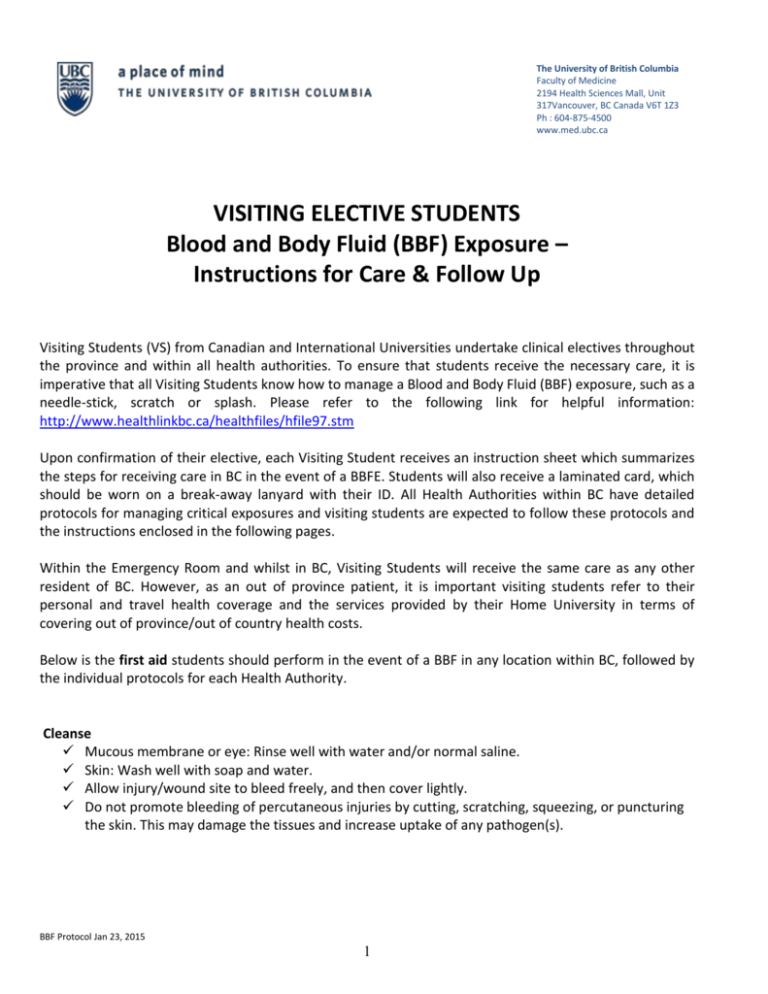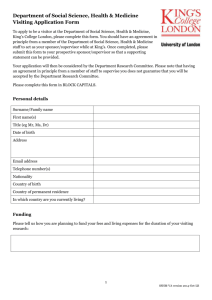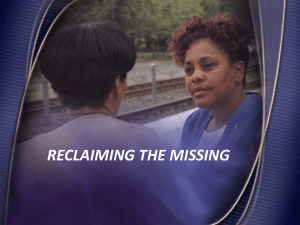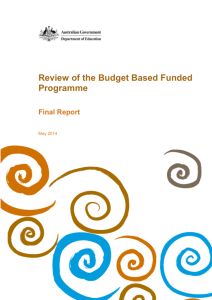VISITING ELECTIVE STUDENTS Blood and Body Fluid (BBF)
advertisement

The University of British Columbia Faculty of Medicine 2194 Health Sciences Mall, Unit 317Vancouver, BC Canada V6T 1Z3 Ph : 604-875-4500 www.med.ubc.ca VISITING ELECTIVE STUDENTS Blood and Body Fluid (BBF) Exposure – Instructions for Care & Follow Up Visiting Students (VS) from Canadian and International Universities undertake clinical electives throughout the province and within all health authorities. To ensure that students receive the necessary care, it is imperative that all Visiting Students know how to manage a Blood and Body Fluid (BBF) exposure, such as a needle-stick, scratch or splash. Please refer to the following link for helpful information: http://www.healthlinkbc.ca/healthfiles/hfile97.stm Upon confirmation of their elective, each Visiting Student receives an instruction sheet which summarizes the steps for receiving care in BC in the event of a BBFE. Students will also receive a laminated card, which should be worn on a break-away lanyard with their ID. All Health Authorities within BC have detailed protocols for managing critical exposures and visiting students are expected to follow these protocols and the instructions enclosed in the following pages. Within the Emergency Room and whilst in BC, Visiting Students will receive the same care as any other resident of BC. However, as an out of province patient, it is important visiting students refer to their personal and travel health coverage and the services provided by their Home University in terms of covering out of province/out of country health costs. Below is the first aid students should perform in the event of a BBF in any location within BC, followed by the individual protocols for each Health Authority. Cleanse Mucous membrane or eye: Rinse well with water and/or normal saline. Skin: Wash well with soap and water. Allow injury/wound site to bleed freely, and then cover lightly. Do not promote bleeding of percutaneous injuries by cutting, scratching, squeezing, or puncturing the skin. This may damage the tissues and increase uptake of any pathogen(s). BBF Protocol Jan 23, 2015 1 Procedures for Blood/Body Fluid (BBF) Exposure for Visiting Students 1. Report the incident to the nurse in charge so baseline blood work on the source patient and risk assessment can be done. You must also inform your preceptor/supervisor of the exposure. You may be able to do this at the time of the exposure. 2. GO TO THE EMERGENCY ROOM AT the NEAREST HOSPITAL within two hours of exposure – THIS IS NOT OPTIONAL. Advise the triage nurse of the BBF exposure so that you can be assessed by a physician and complete blood work. Inform the ER that you are a visiting medical elective student and not a BC resident. 3. In ER, You will be asked to complete a Ministry of Health Form 2339/2340. These forms function as the lab requisition and instructions for the follow-up physician, respectively. The 2339 form will consolidate your information and the “source” information. On Form 2339, when asked about your Employer, indicate that you are a Visiting Medical Student and list the name/contact within your Home University and the name/contact of your Family Physician. Keep a copy of the forms for your records and to bring to present to the follow up physician. Ensure that you leave ER with the source name and PHN/DOB. Process for Obtaining the Lab Results in each Health Authority: VANCOUVER COASTAL, NORTHERN & INTERIOR HEALTH Blood work will be sent to the Provincial Labs. To obtain the results, bring Form 2339 to a walk-in clinic 2448 hours after the blood is drawn, and a physician can review the results with you. The clinic will call Provincial Labs at 1-877-747-2522 to request that the results are faxed to the clinic. Request that walk-in clinic forward the results to your Family Physician. (It is important that you see a physician while in BC to ensure that you receive instructions for care & to avoid delays of receiving results out of province). VANCOUVER ISLAND Report the BBF to VIHA Infection Prevention and Control as they will have received Form 2339 and can report the lab results. They will have received Form 2339. Infection Prevention and control will review the incident and provide counseling, recommendations, and follow-up testing. - Call Dr. Pamela Kibsey, Associate Medical Director : 1-250-519-1626 (pamela.kibsey@viha.ca) or 1-250-370-8699 and ask for Microbiologist on call Provide the source name and PHN or DOB. 4. Report the incident to the UBC Visiting Student Electives Program Manager/Assistant in the UBC MD Undergraduate Dean’s Office who will facilitate collaboration with the Department, your Home School and the Office of Student Affairs, if required. UBC Visiting Student Electives: 604-875-4500 or Program Manager - kelly.jacobs@ubc.ca (604-8754111 x 66482) 5. Mandatory: Students and Supervisors/Preceptor must report the Incident to UBC Risk Management: a. b. c. d. e. Go to http://riskmanagement.ubc.ca Click: Report an Accident or Incident (orange button) Select: 2B - UBC Practicum/Clinical Placement Student's Report of Occupational Injury or Disease Under Person Involved Select: Visitor/Volunteer/Visiting Student Complete the report as prompted 2 Preceptors/Supervisors must complete 2A: Practicum Supervisor/Preceptor Report of Occupational Injury or Disease 6. Contact your home University to confirm the process for reporting the BBFE and inquire about the compensation/insurance coverage of their University for out of province/out of country health care. Note: You may be charged for medical care at Emergency. You may be reimbursed for the fees through your own health/travel medical insurance Ensure that you follow up with your Family Physician as soon as possible to ensure the incident has been documented and to outline any steps for care 3







